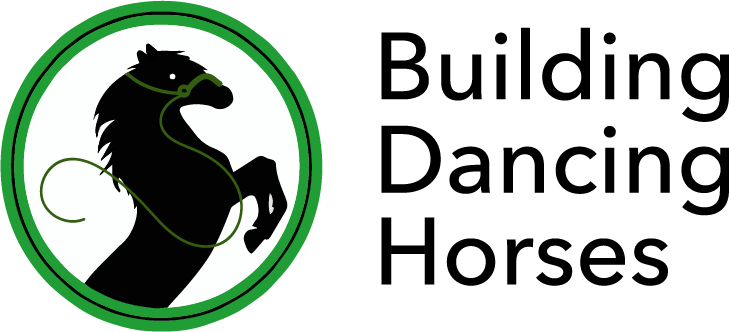Before we can ask, “Why Building Dancing Horses?,” we must first answer, “What is Building Dancing Horses?” Simply put, it is an idea about a new way of reaching people concerning safety, quality, and leadership. It’s an idea different from anything I have seen, read, or even heard about, but nonetheless an idea that has been proven useful to me. As you read the monthly short stories that come from Building Dancing Horses, you should not look at them as a replacement for anything you are already doing with safety, quality, and leadership. Instead, look at them as another arrow in your quiver which I am sure already has many arrows comprised of what you and your companies do to ensure the safe completion of a quality project, utilizing proper leadership. Building Dancing Horses is an idea that was borne from panic and necessity, but one that quickly left panic behind, and instead evolved into something useful, proactive, and yet still quite unique.
A few years back I was sitting at my desk going about my often mundane, but ever challenging, duties of being a Project Manager, which usually consisted of managing a series of small, but none the less important, crises occurring between the five to ten simultaneously-occurring construction, maintenance, and turnaround projects assigned to me. As I sat there looking into the standard series of problems that always seemed to deal with material, personnel, subcontractors, payments, etc., a call came across my cell, but it wasn’t another of the sky is falling crisis calls to add to the existing problems I was already handling that day. No, this call was a more dreadful one about an incident that resulted in an injury on another project manager’s job site, an injury that hit way too close to home for me. I know some of you will balk at what I am about to say. Others will immediately stop reading this introductory story altogether as it goes against the industry standard of all incidents and injuries are horrible regardless of how minor they are. This injury, however, was unlike any other I had been this close to before because this was an incident that could not be addressed with a trip to an occupational health clinic, a root cause analysis, or a lessons learned meeting. This incident immediately sickened my stomach and buckled my knees as I attempted to get up from my desk to head over to our safety director’s office. This particular incident and the corresponding injury was very difficult for me to handle emotionally. It shook me to my core because I finally had some sort of realization of what my mother felt when she got the phone call informing her that her husband, my father, had been electrocuted at work back in 1969. Thank goodness this incident was not a fatality and I truly wish it never would have happened, but it did. It was this specific incident and the resulting injury that were the catalysts which started me on my journey toward Building
Dancing Horses. As I fell back in my chair, unable to stand, I bent my head in prayer, not just any prayer, but the type one does whether they are religious or not. It was the type of prayer that went out in unison on that horrible day in 2001 when our country was attacked. I just sat there in stunned silence praying for a miracle, praying that another family would not have to go through the suffering my family experienced in 1969, suffering that is still felt to this very day. After a period of time, I regained my composure, stood up and headed out the door toward our HS&E department to see what assistance, if any, I could be.
As the vague details of the incident started trickling in, I struggled to understand not only what had happened, but more so, how this could have happened. Office phones buzzed, cell phones rang, clerks and other managers moved in and out bringing copies of qualifications, training records, and other sorts of pertinent information necessary to investigate an incident. Job Safety Analysis’ were photographed and sent in, permits were scanned and emailed, and statements began to be taken. Regardless of how much and what type of information was gathered, my mind still struggled with how this could have happened. I mean, this was the one thing our industry is supposed to do better than others and yet here I was still sickened and trying to wrap my hands around how in the world this could possibly have happened. This is the point where my editor let me know that I needed to share details of the incident and we all know that I can’t, but I am sure we all get the point as to the severity of some incidents.
Over the next couple of weeks several different incident investigation teams, each from different companies and organizations, did their due diligence sorting through the facts. As the initial results of these investigations came out, I still found myself no closer to being able to answer how this could have happened, especially with all of the safeguards put in place. Then it hit me, not in a sense that I understood how it happened, no, I suddenly realized this could have happened on one of my job sites as well. My realization was even worse than that because I realized a serious incident could happen on any job site, in any profession, and in any company or organization, regardless of any and all of the safeguards put in place. This is what both confused and frightened me. Again, I know what I am about to say goes against everything we have been taught by companies and clients alike, but it needs to be said. Yes, all incidents and injuries are preventable, but why aren’t they? With all my years in the industry, with all my training, with all the Zero Hurts initiatives I have participated in, ashamedly it was up to this point I had either failed to realize or had chosen not to realize serious incidents could still happen anywhere.
Oh, it is not because of lack of qualifications, lack of training, lack of policies and procedures, or lack of direction, but because of a lack of something more difficult to teach, and even more difficult to knowledge check. I realized what was missing was a lack of something that must be instilled and subsequently mentored from the top down, and that is a belief in something that is truly more important than cost, schedule, production, process, or any of the supposed the sky is falling crises that continually arise on all job sites. What was I going to do with this realization? Would another safety stand-down work and if so, then how long would it be before we would have to attend yet another safety stand-down for another incident somewhere in the industry? Could I say the time frame between my father’s death in 1969 and this incident was an acceptable length of time between having to experience that gut-wrenching feeling? How could I ensure I drove this very real concern home to everyone in a uniform manner, so as not to deviate at all from one job site to the next?
First off, I had to reach all of my supervisors with the same message, all at the same time, and they had to mentor it down to their employees. Then I, as senior management, needed to ensure I was speaking about this on individual sites, to individual persons regardless of title and position, so if anyone or anything, ever challenged safety, everyone in a uniform voice would say “No,” because they would know and believe safety comes before everything else and they had heard it personally from the top. However, how we would immediately reach all of them with uniformity was still a question that needed to be answered. Not long after coming to this realization, I spoke to my staff and asked them how I could get a uniform message across to all of my job sites simultaneously; reiterating I wanted to ensure all of my supervisors heard the exact same message: safety comes first regardless of what anyone said, regardless of what anyone did, and regardless of whatever supposed crisis needs to be averted. I needed a uniform message that we would never step outside of our policies and procedures for anyone or for any reason.
These job site crises were not new to us and as a matter of fact we dealt with them daily and still do. I remember dealing with one such crisis in which a hazard could not be eliminated before starting the scope of work and as we reviewed the problem, one of our safety directors told us, “We could all probably do this job one hundred times without an incident, but just remember, it’s all good until it isn’t.” Our team immediately went back through the scope of work and the project execution plan several more times before admitting to ourselves this scope of work could not be safely executed within our policies and procedures, or within governmental regulations. We then made what we knew would be a hard call and immediately explained to the client the project could not be completed without an outage. Their response was kind, but not correct, as they replied, “It’s ok, we will just find someone else to do it or do it ourselves.” I am sure someone else did the work, but at what risk? This is what I needed to get across to everyone uniformly, that absolutely nothing is worth skirting, or even worse, going outside of our policies
and procedures. I told my staff I needed to be able to reiterate to all my supervisors my belief had to be their belief which is safety must be the first and last part of every single decision they, and everyone else on their job sites, made. This belief could never be compromised by anyone, regardless of the supposed crisis.
Then we came up with something, a stop gap measure in the beginning, a mass email, a uniform message from me to every single supervisor that would drive home my belief safety not only has been, but still is, and will always be, the single, most-important factor in making any decision on a job site. That uniform message is our policies and procedures are unwavering when it comes to both following and enforcing them. Regardless of what pressures they may feel, nothing, not one single thing is allowed to compromise this belief. With this, my first mass email went out. I was not sure where this outreach would go, but I truly hoped it would be different from anything we were currently doing and by doing something different we could make a lasting change by driving home my belief, my commitment, that there is no substitute for safety. Were my weekly emails working? I believed so as with each successive week, more and more feedback came in, usually a defensive question about how someone felt a particular message was directed at them. My response to their defensiveness was to let them know there was an interesting correlation to their concerns and the reactions pastors must get after every sermon. I then added, “If the shoe fits and you don’t like how it looks or feels, then change it.” Since I believed it was working, I planned to continue my brief mass emails, but fate had a different idea about what was needed.
Due to events on a job site, my weekly emails turned into word documents and the topic of safety was expanded to include quality control, because after all, a quality installation is most definitely directly tied to safety. Thus, my weekly mass correspondence continued, and my mind eased a little knowing I was reaching every one of my supervisors with a uniform message about my, now all of our, commitment to safety and quality. I was pleased with the feedback and although some of it was sarcastic, that was okay with me because the United States Navy always taught me a complaining sailor is a happy sailor, even if the navy didn’t use the word complaining. As weeks went by, I found myself thinking that something was missing. I knew even though the weekly correspondence was personal and addressing safety and quality, as well as openly discussing areas where improvement was needed, I just wasn’t driving my message home like I wanted. Heck, I wasn’t sure by this point all of the recipients were still reading what I had to share, because some of them regularly complained my correspondence was getting too long.
Lucky for them I took a hard look at the brief, uniform, weekly correspondence I was sending and decided the only way to truly drive home a clear message was to make our weekly communication longer, and thus weekly letters were born. Oh, the grumbles came in and with every successive grumble about it taking too long to read, I simply addressed their concerns by putting in more information, wrapped around sarcasm, analogies, and anecdotes. It was a good thing I have always been an active reader because I found I needed the experience of reading to properly write our rapidly-evolving weekly letters. Even with the effort I was putting in, still some complained, but it didn’t mean they lacked the desire to put in a quality job, safely. Nope I came to realize it merely meant they lacked the leadership skills necessary to strive to become better-informed and better-trained supervisors, to actually become leaders. I thought back to all the leadership training the United States Navy put me through, and it was with that realization I started adding leadership to our weekly letters.
With each successive letter, with each successive analogy, anecdote, and with each successive bit of sarcasm, the membership into our little club grew as my supervisors started requesting I add other coworkers, who worked for different managers, to our email list. Now I am sure not all these referrals were made with the best of intentions in mind. I am unapologetic about this realization as I knew, at times, our group was growing out of a need to share the misery of reading my long-winded letters with others. Isn’t a win a win, especially when dealing with safety, quality, and leadership? Surprisingly, I wasn’t running out of ideas, and I continued to write weekly letters, expanding our correspondence to include quotes, song, and movie titles, and even holiday themes, all of them revolving around safety, quality, and leadership and we continued to reach people!
Then fate knocked again on what I was trying to accomplish and the unique way I was going about it when I attended a seminar and heard a few motivational speakers share their stories with their unique tag lines and business names. It was the upbeat and humorous speakers whose information I best retained, and this got me thinking maybe it was time to change what I was doing and come up with a cool business name and a tag lime. Maybe I could reach more people if I just did the same things those humorous and energetic motivational speakers did.
Did I move on this incredible idea? No, I continued to write weekly letters that rapidly evolved into three pages written in block letter format, consisting of between 2,000 and 3,000 words. I was surprised with every increase in the number of words, our membership grew accordingly, and so did the complaints. “I didn’t sign up to be a supervisor so I could read novels,” someone would complain, but with every complaint, two compliments would come in. “My goodness you are long-winded,” a coworker would blurt out while reading that week’s letter. “If I promise you that no one will ever get hurt on one of my jobs, can I stop reading your damned novels?” someone else would tell me.
I suddenly found myself to be a prophet of sorts with my weekly correspondence speaking directly to our group through anecdotal short stories, sort of like Jesus did when he shared parables with his disciples. In reality, I know I am not a prophet and am even reminded of this fact by a pretty little blond lady who said, “The one thing you are definitely not, in any way, shape, or form, is Christlike.” I did not let her negativity sap my spirit, but instead stayed the course and my writing style continued to develop so with each successive letter my sarcastic artistry reared itself higher and higher, some saying it was as if it was begging to be cut off. But hey, I knew what I was doing was right because I was reaching people and we were openly have in-depth conversations about safety, quality, and leadership, and were having fun while doing so.
One year passed, then the second, and I believed I had finally settled into a writing style, and I take this time to give credit to all those great authors I grew up reading. Unfortunately, Jack London, Stephen King, Tom Clancy, Ann Rule, and John Grisham didn’t play much of a role in the development of my style of writing, although some would say it wouldn’t have been a bad thing if they had. They didn’t, however, and as I developed the style of my letters over those two years, it was books of short stories shared by my uncle, when I was a teenager, that had the greatest impact on what had developed into my very own short stories about safety, quality, and leadership. These stories proudly included sarcasm, analogies, and anecdotes, just like the great storyteller, outdoorsman, and anecdotal author Patrick E. McManus. Yes, it was McManus who helped guide my pen alongside my personality and with that, guided the way in which I deliver my short stories about the ever-important topics of safety, quality, and leadership.
I would hope people won’t be dissuaded from reading my short stories just because they are a different and unique way of reaching people. After all, who doesn’t like a good-humored short story, especially if it could help us become better leaders who consistently strive to bring in a quality project, safely? I mean, isn’t it a fact humorous anecdotal short stories are definitely more entertaining than self-help books. Which one of you hasn’t invested your time and resources reading self-help book after self-help book, searching for a magical bit of knowledge that might help you become a better supervisor, a true leader? How about you try one of these short stories instead and see if you don’t enjoy them more?
When I started this journey, out of necessity, little did I know by combining Christ’s holy wisdom of teaching using parables, McManus’ anecdotal short stories, and my very own artistic sarcasm, that one day we could add an additional layer to the way we instruct and motivate people in safety, quality, and leadership. I never would have guessed my initial email burst would lead to me pulling the proverbial trigger and kicking off my very own LLC.
It is with much soul searching, excitement, and trepidation I introduce Building Dancing Horses – Amusing Anecdotes about Safety, Quality, and Leadership. I come to the end of this introductory story with the knowledge I do realize that I am not a college-educated author, even though I now ask that same pretty little blond lady to address me as King Author. Furthermore, I do realize I have a lot to learn and I will make mistakes in writing these short stories; therefore, I welcome anyone’s feedback who would like to share it. However, the most important thing I understand is my heart is in the right place as I try to reach supervisors, young and old, through a unique method that has become Building Dancing Horses; a unique method that should be able to hold someone’s attention longer than a video, a computer course, or a self-help book.
Let me close by answering one last question. Why the name Building Dancing Horses? Well, first, building something as amazing as a well-trained Dressage horse, through proper training and the retention of that training, is much better than building current and future leaders the way industry often does by using outdated, poorly produced videos, and monotone speakers. I would have preferred to go with name recognition as after 52 years of life and 25 years in the industry, I believe my name is well known and maybe, just maybe, slightly respected. Unfortunately, a quick search of Google and Facebook showed me my name is about as common as John Smith. Yes, my parents used all their teenage wisdom and experience to ensure my first, middle, and last names could all be used as first, middle, and last names, regardless of the order in which they were placed. Don’t get me wrong, my last name cannot be blamed on my parents. I do forgive them for the dilemma they put me in, because there was simply no way they could have ever known I would one day be searching the world wide web looking at the countless similarities to my name so I could open an LLC. Anyway, I digress as what I am trying to share is why the name of my effort to reach people about safety, quality, and leadership, is Building Dancing Horses. It is with this I close this introduction story and will soon send out my very first short story about safety, quality, and leadership named A Dancing Horse.







